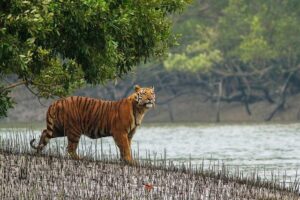
Sunderbans National Park is located at the South Eastern tip of the 24 Paraganas district in West Bengal. The Sundarbans are a part of the world’s largest delta formed by the rivers Ganges,Brahmaputra and Meghna. Sundarban is a vast area covering 4262 square kms in India alone, with a larger portion in Bangladesh.
2585 sq. kms of the Indian Sundarban forms the largest Tiger Reserve and National Park in India. The total area of the Indian part of the Sundarban forest, lying within the latitude between 21°13′-22°40′ North and longitude 88°05′-89°06′ East, is about 4,262 sq km, of which 2,125 sq km is occupied by mangrove forest across 56 islands and the balance is under water. The forest is called ‘Sunderban’due to the rich growth of Sundari trees.
The park is surrounded by a buffer zone of 885 square kilometres. This also mainly consists of mangrove forests. The core area of the park has its own natural boundaries with the river Matla on its West, the river Haribhanga on its East, with Netidhopani and Gosba in the North.
The four Sunderbans national parks have been lumped together as they all share common features of the estuarine mangrove ecosystem. This place is bisected by complex network of mudflats, tidal waterways and small islands of saline mangrove forests, presenting an excellent instance of the ubiquitous ecological processes. The wide range of fauna, flora and avifauna is one of the distinct characteristics of Sundarbans which include more than 250 species of birds and the ferocious Royal Bengal Tiger along with the estuarine crocodile and the Indian python.
The Sundarbans had been declared the core area of Sundarbans Tiger Reserve in 1973 and a wildlife sanctuary in the year 1977. In 1984, the Indian government declared the area a National Park. UNESCO designated Sundarbans National Park a World Heritage Site in 1987. The whole Sundarbans area had been declared a Biosphere Reserve in 1989.
Outstanding Universal Value
The Sundarbans contain the world’s largest mangrove forests and one of the most biologically productive of all natural ecosystems. Located at the mouth of the Ganges and Brahmaputra Rivers between India and Bangladesh, its forest and waterways support a wide range of’ fauna including a number of species threatened with extinction. The mangrove habitat supports the single largest population of tigers in the world which have adapted to an almost amphibious life, being capable of swimming for long distances and feeding on fish, crab and water monitor lizards. They are also renowned for being “man-eaters”, most probably due to their relatively high frequency of encounters with local people.
The islands are also of great economic importance as a storm barrier, shore stabiliser, nutrient and sediment trap, a source of timber and natural resources, and support a wide variety of aquatic, benthic and terrestrial organisms. They are an excellent example of the ecological processes of monsoon rain flooding, delta formation, tidal influence and plant colonisation. Covering 133,010 ha, the area is estimated to comprise about 55% forest land and 45% wetlands in the form of tidal rivers, creeks, canals and vast estuarine mouths of the river. About 66% of the entire mangrove forest area is estimated to occur in Bangladesh, with the remaining 34% in India.
Criterion (ix): The Sundarbans is the largest area of mangrove forest in the world and the only one that is inhabited by the tiger. The land area in the Sundarbans is constantly being changed, moulded and shaped by the action of the tides, with erosion processes more prominent along estuaries and deposition processes along the banks of inner estuarine waterways influenced by the accelerated discharge of silt from sea water. Its role as a wetland nursery for marine organisms and as a climatic buffer against cyclones is a unique natural process.
Criterion (x): The mangrove ecosystem of the Sundarbans is considered to be unique because of its immensely rich mangrove flora and mangrove-associated fauna. Some 78 species of mangroves have been recorded in the area making it the richest mangrove forest in the world. It is also unique as the mangroves are not only dominant as fringing mangroves along the creeks and backwaters, but also grow along the sides of rivers in muddy as well as in flat, sandy areas.
The Sundarbans support a wealth of animal species including the single largest population of tiger and a number of other threatened aquatic mammals such as the Irrawaddy and Ganges River dolphins. The site also contains an exceptional number of threatened reptiles including the king cobra and significant populations of the endemic river terrapin which was once believed to be extinct. The property provides nesting grounds for marine turtles including the olive riley, green and hawksbill. Two of the four species of highly primitive horseshoe crab (Tachypleus gigas and Carcinoscorpius rotundicauda) are found here. The Sajnakhali area, listed as an Important Bird Area, contains a wealth of waterfowl and is of high importance for migratory birds.
Source:
http://whc.unesco.org/en/list/452
https://yichuans.github.io/datasheet/output/site/sundarbans-national-park/
http://www.sunderbannationalpark.in/about-sunderban-national-park.html


